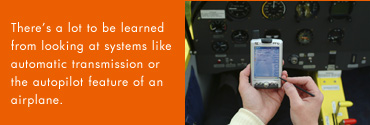
By Amy Cowen, August 2006
As today’s enterprises struggle to adapt to rapidly
changing business models, IT departments are under constant
pressure to do more, do it faster and do it with less.
Hiring additional staff is a common response, but human
resources already account for a large percentage of IT
costs. Adding more people into the IT loop only increases
both risk and cost in data center operations.
For researchers in HP Labs, the path to increased agility,
improved performance, mitigated risk and maximum return
begins not with people but with the automation of labor-intensive
IT tasks and data center operations.
Tasks that can be automated are typically those that
are better suited to machines than people. They may be
repetitive and tedious, or involve a precise set of actions
that must be conducted in a specified order. Other tasks
ripe for automation may require processing and making
decisions on huge amounts of data in seconds.
Because these tasks are a mismatch for human cognitive
skills, people make mistakes and inject costly errors.
Kumar Goswami, who leads much of HP Labs' automation
research, says there’s a lot to be learned from
looking at systems like automatic transmission or the
autopilot feature of an airplane.
"These things are designed as closed-loop, self-managed
systems from day one,” he says.
Traditional IT systems, on the other hand, are not closed-loop
systems. Instead, IT systems are developed in an ad-hoc
manner; error handling, monitoring, security and management
are not designed into the systems from the beginning.
HP Labs is taking a more structured approach, applying
well-known techniques used in physical systems such as
control theory, statistics and formal mathematics to
develop IT systems that are more automated, less prone
to errors and more agile and predictable. This frees
up people from tedious maintenance chores and allow them
to focus on innovation.
"Our vision," Goswami says, "is one in
which the user expresses the 'what,' but not the 'how,'
and our tools do the ‘how.' "
Model-driven automation -- along with high-level policies
and service-level objectives to manage the entire lifecycle
of the systems and their applications – is critical
to HP Labs’ approach. These models are standards-based,
formal, abstract and machine-readable representations
of an entire system including hardware, infrastructure,
applications, processes and properties.
“We take a holistic and structured approach to
automation,” says Goswami. “It’s structured
in that we do things at the model level. It’s holistic
in that, ideally, everything is approached from a model
standpoint. And, on top of that, it’s agile --
nothing is hard-coded to a specific set of tools, systems
or models.”
Models, coupled with a service-oriented architecture,
make it possible to work with heterogeneous systems.
That makes HP unique in the automation space.
From Goswami’s vantage, companies can start the
transition to automation by automating select or specific
processes.
"You don't have to do it all at once," he
says. As long as businesses plan in advance, they can
start automating where it makes sense to them.
“Ultimately, we need to automate everything about
IT, from the design to the deployment to the management
during operations," he says.
In an automated system, a customer describes a desired
service, including properties such as its availability,
the service-level objectives and any other constraints
(or policies) that need to be taken into account. HP
Labs’ technologies then automate the process of
creating a particular instance -- or model -- of the
service.
But the process doesn’t end there.
Automation continues throughout the entire life cycle;
each model builds on the previous one. For example, a
resource-allocation tool will use the model to figure
out what resources to allocate. It will then add this
to the model. The deployment engine will look at the
model (which now consists of the specific architecture,
components and resources) and deploy the service, then
update the model to reflect that.
Once a specific model is established, tools can automate
every step of the service or process, including resource
allocation, deployment, provisioning, optimization and
maintenance.
An early example of HP Labs’ approach to model-driven
automation took shape in the implementation of the Shared
Application Server Utility (SASU) for HP-IT.
HP's IT department developed SASU to provide BEA WebLogic
as a service so that separate teams could use the shared
service rather than buying and maintaining their own
application servers. SASU helped counteract high software
licensing costs, under-utilization of existing hardware
and redundant support and maintenance within HP-IT.
As the number of applications using SASU increased,
accurate provisioning and planning became a challenge.
Monitoring and maintaining the growing shared environment
involved time- and resource-intensive capacity-planning
tasks that took 7-10 days each month. An additional 2-3
days was required to clean data used for the task.
HP Labs was able to solve this problem by automating
the data-cleaning process, reducing the tedious manual
process to a matter of hours. The team then automated
data analysis, which not only saved time, but produced
more accurate results.
Another area researchers are exploring is automating
problem diagonisis for businesses.
"This is a very difficult problem for our customers.
They get tremendous amounts of data from applications
and from the systems, and they’re under pressure
when the system is not working properly to diagnose what
the issue is and fix it in a timely fashion."
Researchers are using statistical and machine-learning
techniques to help customers more quickly sift through
data and determine what will be most useful in solving
a problem. In addition, developed technologies to take
a digital "snapshot" of the system when it
is not functioning properly and compare it to previous
snapshops to determine if a particular problem occured
in the past and how it was resolved.
"By automating tasks like these, you're able to
create an agile repeatable, and more importantly, a very
predictable IT environment," Goswami says. "That's
what CIOs are looking for."
|

